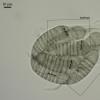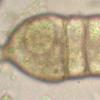
20-12-2025 23:08
Patrice TANCHAUDBonsoir, récolte sur sol sablonneux dans l'arri�

20-12-2025 15:47
Mirek GrycHi.These grew on pine wood that was heavily covere

18-12-2025 21:17
Pol DebaenstThe identification took me to Byssonectria deformi

15-12-2025 07:09
 Danny Newman
Danny Newman
indet. Rutstroemiaceae sp. on unk. fallen leavesMc

19-12-2025 10:10
Patrice TANCHAUDBonjour, récolte réalisée en milieu dunaire, a

18-12-2025 17:23
 Bruno Coué
Bruno Coué
Bonjour,je serais heureux d'avoir votre avis sur c

18-12-2025 18:07
Margot en Geert VullingsThese plumes were found on rotten wood.They strong

17-12-2025 18:35
 Michel Hairaud
Michel Hairaud
Bonjour à tous/Hi to everyone I am passing along
The spores remind Sporormiella heptamera, but i don't think it is that species, and probably not Sporormiella.
Perithecia pear-shaped, to 200 high, 150 broad, with straight bristles in upper part, site scattered, not or partly immersed.
Excipulum from angular brown-walled cells 10-15 at flanks, some smaller near the pore; bristles 100-150 long, 5-7 width at base, brown, thick-walled, segmented; asci fissitunicate, utriform, 114-135 x 66-80 (unexpanded); spores 7-8-celled, broad-cylindrical, with obtuse, larger top and end segments, other segments short-cylindrical (remind caterpillar in shape), hyaline, finally becoming brownish, with punctate ornamentation, 45 (41-50) x 16 (14,3-17); paraphyses 1,5-2 broad, with gelatinose sheath.
Growing on bird (Lagopus lagopus) dung, nearby with Trichodelitschia bisporula and Lasiobolus sp.

Very interesting case, but confusing. Despite the particular form asci, spores appear close Sporormiella. Should find psores asci and mature. There is little known species of Sporormiella with hair.?
Michel.
The spores and asci look very much like something in Extrawettsteinina. Check Barr, 1972 Preliminary Studies on the Dothideales in Temperate North America for generic description.
Barr, 1987 (Mycotaxon 29: 502) published a new combination, Extrawettsteinina andromedae (Auerswald) Barr but I don't see a description.
It is interesting that you have it on dung.
Sincerely,
Adrian Carter

I've seen more than 30 species of Sporormiella and I'm sure that your little fungus is another genus.
Never I've seen such asci and spores.
When I looked in Barr: Prodromus to class Loculoascomycetes (1987) I found, that Kriegeriella has such asci and similar spores.
Maybe Extrawettsteinina also, like Adrian wrote.
You should also look for Wettsteinina andromedae.
Very interesting!
Norbert
I have found the description of W. andromedae in Vasilyeva (1998), and another from Barr. The spores there described with 3 septa, with gelatinose sheath, and the shape at the drawing doesn't fit. I will be looking further.
There the description and picture from Barr (1967. Northern Pyrenomycetes: III. Western species. Canadian Journal of Botany 45, 1041–1046.).
Probably, it is underdescribed species of Kriegeriella? - i am not expect to proceed with it further myself, since lack of experience in taxonomy and in this group. So, someone's interest in such work welcome.
There are two works which i am lacking. May somebody share them with me?
Barr, M.E. (1972). Preliminary studies of the Dothideales in temperate North America. Contributions from the University of Michigan Herbarium 9 (8): 523-638.
Barr, M.E. (1987). Prodromus to Class Loculoascomycetes. 168 pp. Amherst, Massachusetts; University of Massachusetts.
And i can share these related works (https://www.dropbox.com/sh/6ajw4dg7khj44hy/VWAwdD0Wkd):
Vasilyeva L.N., 1987, Pyrenomycetidae and Loculoascomycetidae of North Far East. [in Russian]
Vasilyeva L.N., 1998, Pyrenomycetidae and Loculoascomycetidae of Far East. [in Russian]
Shoemaker, R.A., Babcock, C.E., 1987. Wettsteinina. Canadian Journal of Botany 65, 373–405.
Minter, D.W., Kirk, P.M., 2007. Kriegeriella mirabilis. IMI Descriptions of Fungi and Bacteria 174.

I shall email you re the 1972 Barr paper
amitiés
Chris
PS I would be interested if anyone has the other one . . .

I have the book by Barr 1987 (the pages I can scan tomorrow) but there's not much can be seen. What bothers me about the genre are the bristles (Perisetes is the preferred term). Would also be possible, perhaps the genus Chaetothyrium. Since there is also a monograph of Hansford in Mycol. Paper No. 15 (1946) which I have not.
Peter
Merci

Peter
Hi Nina,
I think it is very comparable with Kriegeriella mirabilis. Please could you see Zhang et al. 2012 Pleosporales Fungal Diversity 53 (P. 186-190).
Regards
Ying

I agree with you right, but what we do with the very clear bristles?
Peter
Yes, spores have similar shape, but probably in this specimen they are bigger. Previous range was measured from hyaline spores. If to measure browned spores (but they are germinating in that case) they will even bigger, about 62 x 21. That is very different from the range in Znang et al. (28–37.5×8–11).
Spores reported smooth in Znang, but Minter (2007) writes that "when brown, more often rough", and my have clear punctate ornamentation when brown.
Ascomata differ in shape (flatened, no opening in K. mirabilis) and in setae. I dont't know about importance of these characters.
I agree with you both, and this species should refer to Barr's pubs on coprophilous fungi. The bristle is a common character of fungi on animal dung.
Warm wishes
Ying


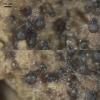
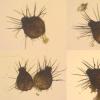
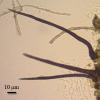
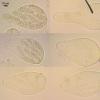
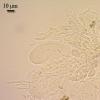
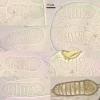
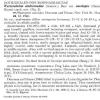
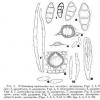
 Barr-Prodromus-1987-46-54-0001.pdf
Barr-Prodromus-1987-46-54-0001.pdf